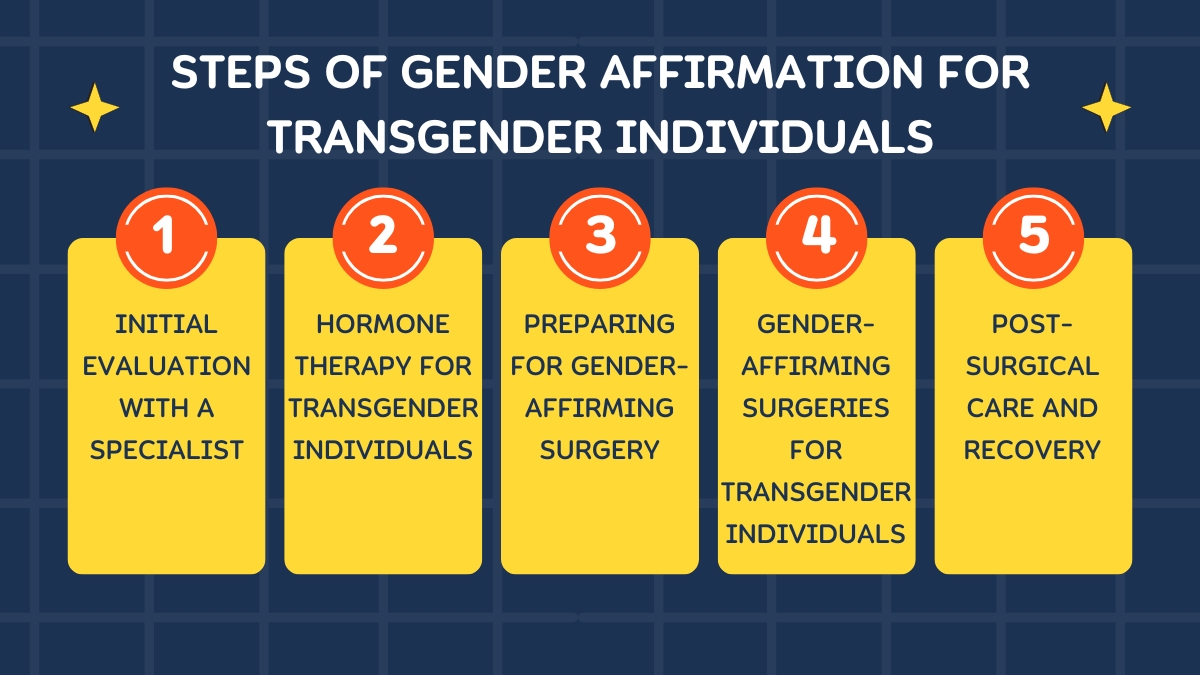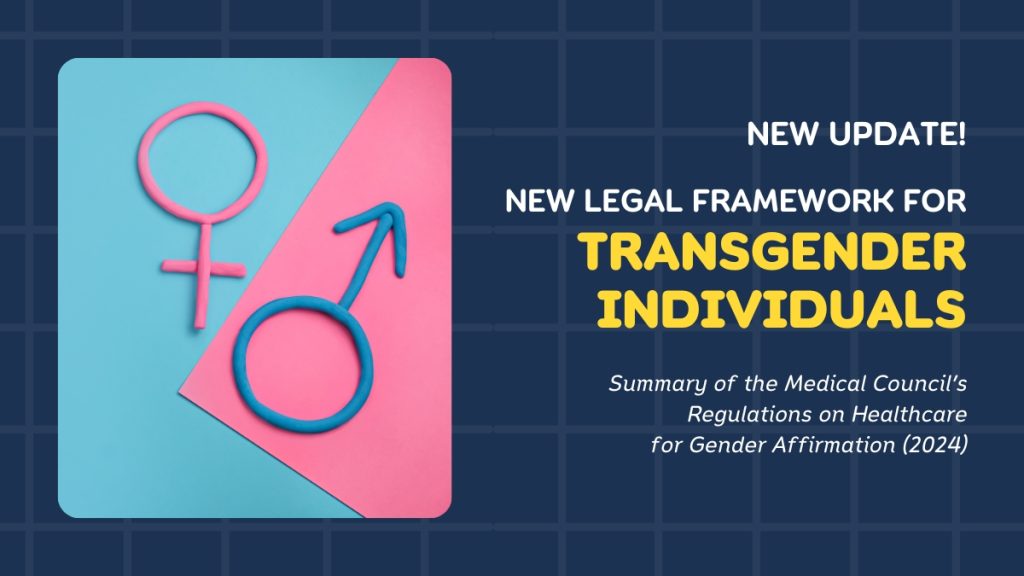In recent years, Thailand has undergone significant policy and legal changes regarding the rights of transgender individuals, particularly in the area of gender affirmation. This issue directly impacts the lives of many people in the community. Recently, the Royal Gazette published an important document under the Medical Council’s Code of Ethics on Healthcare for Gender Affirmation, outlining standards for medical care. This marks a crucial step towards achieving greater equality and ensuring safe access to healthcare services for transgender individuals in Thailand.
What is Gender Affirmation for Transgender Individuals?
Gender affirmation refers to the process in which individuals align their physical, social, and legal identity with their gender identity. This process includes various aspects, such as:
- Hormone Therapy Transgender individuals can undergo hormone therapy to help their bodies develop characteristics that align with their gender identity. For example:
- Estrogen for individuals transitioning to female
- Testosterone for individuals transitioning to male
- Gender-Affirming Surgeries This includes procedures such as:
- Chest surgery (mastectomy or breast augmentation)
- Genital reconstruction (creating or removing reproductive organs)
- Other body modifications to align with gender identity
- Legal Document Changes Individuals may update their official documents to reflect their gender identity. This includes:
- Name changes
- Title and gender marker updates on identification documents such as national ID cards, passports, and driver’s licenses
- Psychological and Social Support Transgender individuals require support from family, communities, and society to help them live confidently and without discrimination.
- Gender Identity in Social Contexts Gender affirmation is not only about physical changes but also about social recognition and rights, such as:
- Dressing according to gender identity
- Using gender-appropriate restrooms and public facilities
- Being acknowledged and respected by society
This process is essential to ensuring the dignity, well-being, and equality of transgender individuals in society.


Key Content of the Royal Gazette Announcement
Recently, the Royal Gazette published new guidelines on gender affirmation, covering several important aspects, including:
- Eligibility and Requirements for Gender Affirmation Treatment Transgender individuals seeking gender affirmation must undergo an assessment process and meet specific criteria, including:
- Being at least 18 years old
- Undergoing a psychiatric evaluation and receiving a diagnosis of Gender Dysphoria
- Receiving medical consultation regarding the impact and implications of the treatment
- Types of Gender Affirmation Procedures The Royal Gazette guidelines outline recognized medical and surgical procedures for gender affirmation, including:
- Hormone Therapy: Balancing hormone levels to align with gender identity
- Gender-Affirming Surgeries, such as:
- Breast surgery (mastectomy or breast augmentation)
- Genital reconstruction
- Adam’s apple reduction surgery (Chondrolaryngoplasty)
- Facial Feminization or Masculinization Surgery: Adjusting facial features to align with gender identity
- Voice Surgery: Modifying vocal tone to match gender identity
- Relevant Legal Changes
- The new guidelines also make it easier for transgender individuals to update their name and gender marker on official documents, such as national ID cards and passports. Additionally, they provide clearer legal rights regarding marriage and other legal transactions, ensuring greater legal recognition and protection for transgender individuals.

Steps of Gender Affirmation
Gender affirmation is a multi-step process that transgender individuals can customize according to their needs. This process includes physical, psychological, and legal changes. The key steps in this process are as follows:
1. Initial Evaluation with a Specialist
Before undergoing medical interventions, transgender individuals should consult a healthcare professional for an initial assessment. This step is crucial to ensure they are physically and mentally prepared for further procedures. The evaluation includes:

| Physical Health Examination | A doctor will conduct a general health check-up to assess the individual’s overall health condition and determine whether there are any pre-existing medical conditions that might affect treatment. |
| Mental Health Assessment | Transgender individuals must meet with a psychiatrist to evaluate their mental readiness for the transition. The purpose of this assessment is not to “diagnose” someone as transgender, but rather to ensure that they can make informed and confident decisions about their transition. |
| Consultation on Available Options |
The healthcare provider will discuss various gender affirmation options, including:
|
| Understanding Risks and Benefits | Transgender individuals will receive detailed information about the pros and cons of different transition methods. This includes possible side effects of hormone therapy and surgical procedures. |
| Developing a Personalized Treatment Plan | Once all aspects have been assessed, the healthcare provider will help create an individualized treatment plan, tailored to meet the unique needs and goals of the transgender person. |
2. Hormone Therapy for Transgender Individuals
Hormone therapy is a crucial step in helping transgender individuals align their physical characteristics with their gender identity. The details of hormone therapy include:
Types of Hormones Used
- Estrogen Therapy (for Male-to-Female, MTF individuals)
- Promotes breast development
- Reduces body hair growth
- Softens skin texture
- Testosterone Therapy (for Female-to-Male, FTM individuals)
- Increases muscle mass
- Deepens voice tone
- Enhances body hair growth
Hormone therapy plays a significant role in gender affirmation and is usually supervised by medical professionals to ensure safe and effective results for transgender individuals.

Hormone Injections
This method is the most popular as it allows for precise control over the amount of hormones entering the body. Hormone injections are divided into two main types:
- Intramuscular Injection (IM): The hormone is injected directly into the muscle, such as the thigh or hip. This method allows for rapid absorption into the bloodstream and provides long-lasting effects.
- Subcutaneous Injection (SubQ): The hormone is injected into the fat layer under the skin, usually in the abdomen or upper arm. This method is less painful and may provide more consistent hormone levels in some cases.
- Injection Frequency: Injections are typically required weekly or biweekly, depending on the type of hormone used and the individual’s response to the treatment.

Oral Medication (Hormone Therapy)
This method is suitable for individuals who do not wish to receive injections or cannot undergo injectable hormone therapy. However, it requires close medical monitoring. Oral hormone therapy is divided into two main types:
- Types of Oral Hormones
- Pills/Tablets The most common form of hormone therapy. Typically taken daily to maintain stable hormone levels in the body.
- Capsules Similar to pills but may contain formulations that provide longer-lasting effects in some cases.
- Precautions
- Certain oral hormones may increase the risk of liver disease and blood clots. It is essential to take them under the supervision of a healthcare provider to ensure safe and effective use.

Transdermal Patches and Topical Gels
These methods provide an alternative for individuals who prefer hormone absorption through the skin.
Types of Skin-Based Hormone Delivery
- Transdermal Patches Applied to the skin and release hormones gradually into the body over time.
- Topical Gels Applied directly onto the skin, allowing hormone absorption into the bloodstream through the skin layer.
Advantages
- Lower risk of liver-related side effects, as the hormones are absorbed directly into the bloodstream without undergoing liver metabolism.
Each method has its own benefits and drawbacks, so the choice should be made based on individual needs and medical advice from a healthcare provider.
3. Preparing for Gender-Affirming Surgery
Hormone therapy is an important step that helps transgender individuals align their physical characteristics with their gender identity. Pre-surgical preparation includes the following:
- Health Check-ups: A thorough physical examination and hormone level testing to ensure the body is ready for surgery.
- Psychiatric Consultation: An assessment to evaluate decision-making capacity and minimize psychological risks.
- Temporary Hormone Discontinuation: In some cases, doctors may recommend stopping hormone therapy before surgery to reduce the risk of blood clots.
- Physical Preparation: Engaging in exercise, getting enough rest, and avoiding smoking or alcohol to promote faster recovery.
- Post-Surgery Recovery Planning: Arranging accommodation and caregivers, as mobility may be limited during the initial recovery phase.
Proper preparation ensures a smoother surgery and helps reduce the risk of complications.
4. Gender-Affirming Surgeries for Transgender Individuals
There are several types of gender-affirming surgeries that individuals can choose from, including:
-
Genital Reconstruction Surgery
- Vaginoplasty: Creating a vagina for MTF individuals.
- Phalloplasty: Creating a penis for FTM individuals.
-
Chest Surgery
- Breast Augmentation: For MTF individuals.
- Mastectomy (Top Surgery): Removing breast tissue for FTM individuals.
-
Facial and Neck Procedures
- Adam’s Apple Reduction (Chondrolaryngoplasty)
- Facial Feminization or Masculinization Surgery to enhance gender-specific facial features.
5. Post-Surgical Care and Recovery
After surgery, transgender individuals require specialized care to ensure proper healing. This includes:
- Wound Care: Keeping the surgical site clean to prevent infections.
- Rest and Physical Therapy: Following the doctor’s recommendations for gradual recovery.
- Regular Follow-ups with Doctors: Ensuring the treatment progresses as planned and addressing any post-surgical concerns.
Proper post-operative care is essential to achieving optimal healing and long-term well-being after gender-affirming surgery.
Benefits of the New Guidelines for Transgender Individuals
The new guidelines published in the Royal Gazette provide significant benefits for transgender individuals across multiple areas, including healthcare, legal rights, and social acceptance. The key advantages of these updated regulations are:
☞ Transgender individuals can receive hormone therapy and surgeries that meet recognized medical standards and are provided by certified specialists.
☞ Reduces the risk of accessing unregulated hormone treatments or seeking care from unlicensed providers.
☞ The new guidelines allow general practitioners to prescribe hormone therapy without requiring specialized certification, making medical access more inclusive and less restrictive.
☞ Clear definitions of gender affirmation help reduce misunderstandings and social stigma.
☞ Updated terminology, reviewed and verified by the transgender community, promotes more accurate and inclusive understanding.
☞ Encourages public and private sectors to provide more inclusive and supportive policies for transgender individuals.
☞ Transgender individuals can now more easily update their gender markers and titles on official documents.
☞ The new guidelines establish clear medical standards for surgeons performing gender-affirming procedures, ensuring the highest level of safety and care.
☞ Healthcare professionals are required to undergo training on transgender healthcare, improving the quality and inclusivity of medical services.
Summary of the Medical Council’s Regulations on Healthcare for Gender Affirmation (2024)
Updated Terminology
- The term “healthcare recipient” replaces “patient” to emphasize that gender affirmation is not a disease treatment.
- The term “gender affirmation” replaces “treatment,” “sex change,” and “gender transition.”
- The phrase “healthcare for gender affirmation” now covers non-medical, hormonal, and surgical care.
Healthcare Process for Gender Affirmation
- Comprehensive health assessment
- Medication to align the body with gender identity
- Gender-affirming surgeries, such as:
- Chest surgery
- Vaginoplasty/Phalloplasty
- Facial and voice modification surgeries
Eligibility for Services
Hormone Therapy
- 18 years and older: Can give consent independently.
- Under 18: Requires guardian consent, unless the doctor deems obtaining consent may endanger the individual’s life.
Gender-Affirming Surgery
- 20 years and older: Can give consent independently.
- 18-19 years old: Requires guardian consent, unless the doctor determines that obtaining consent may pose a life-threatening risk.
Qualifications for Surgeons Performing Gender-Affirming Surgeries
- Must be a plastic surgeon, gynecologist, otolaryngologist (ENT specialist), or a related specialist as designated by the Medical Council.
- Trainee doctors undergoing relevant medical training are also permitted to provide services.
Pre-Surgical Requirements
- A comprehensive health assessment must be conducted.
- A psychiatric evaluation is required to assess the individual’s decision-making capacity.
- The health evaluator and the surgeon must be different individuals.
Requirements for Doctors Practicing Before the Regulation Takes Effect
- Must notify the Medical Council within 90 days after the regulation comes into effect.
- The Medical Council will provide both short-term and long-term training programs to certify doctors who wish to offer gender-affirming healthcare services.

FAQ
Answer = The new guidelines take effect immediately after being published in the Royal Gazette. Further adjustments and refinements are currently underway to ensure compliance with established standards.
Answer = The cost varies depending on the type of procedure and the hospital providing the service. Generally, the price ranges from 100,000 to 500,000 THB, depending on the specific surgery and additional expenses.
Answer = Doctors typically recommend being on hormone therapy for at least one year before undergoing gender-affirming surgery. This allows the body to adjust and ensures the individual has made an informed decision.
Answer = Not in every case! However, for hormone therapy or surgery, most doctors require a psychiatric assessment to ensure that the individual fully understands the transition process and its long-term effects.
Answer = The age requirements for hormones and surgery differ. Certain hormone treatments may be initiated during adolescence under medical supervision. However, most surgeries require the individual to be at least 18 years old.
Answer = Start by gathering information and consulting a doctor. If unsure about where to begin, seek advice from specialist doctors or organizations that provide guidance on gender affirmation.
Answer =Not always! Some individuals may require lifelong hormone therapy, while others may be able to discontinue it once they are satisfied with the results. However, long-term hormone use affects the body, so it is essential to consult a doctor regularly.
Related Articles
- Hormone Therapy Access Expanded for Transgender in Thailand
- The benefits that same-sex marriages in Thailand deserve
The newly announced guidelines in the Royal Gazette on gender affirmation mark a significant milestone in supporting transgender rights in Thailand. The clearer policies and regulations now ensure that transgender individuals can access medical services and legally affirm their gender identity in a safer and more equitable manner.
One of the most crucial updates is the expanded authority for general practitioners to prescribe hormone therapy, making medical care more accessible and reducing previous barriers to treatment. This also raises the overall standard of transgender healthcare in the country.
Additionally, the guidelines establish clear conditions and procedures, including age-specific requirements, psychiatric consultations before surgery, and refined definitions of gender identity. These improvements help foster better societal understanding and reduce discrimination.
With stronger support from both the government and society, transgender individuals in Thailand can now live with greater confidence, security, and dignity.
While these positive changes mark a significant step forward, ongoing monitoring and further policy development remain essential to guarantee equal rights and opportunities for all transgender individuals across every aspect of life. Society must continue to provide support and foster inclusivity, ensuring that everyone can express their gender identity safely and gain genuine acceptance.
The latest updates in the Royal Gazette regarding gender affirmation represent a milestone for transgender rights in Thailand. By establishing clear medical guidelines and aligning legal frameworks with the needs of transgender individuals, these changes will empower them to live with greater confidence, security, and dignity.
Reference:
ข้อบังคับแพทยสภา ว่าด้วยการรักษาจริยธรรม แห่งวิชาชีพเวชกรรม เกี่ยวกับการบริบาลสุขภาพ เพื่อการยืนยันเพศสภาพ
- ratchakitcha.soc.go.th/documents/59327.pdf
การรับรองเพศสถานะตามกฎหมายในประเทศไทย
- undp.org
การใช้ฮอร์โมน เพื่อการยืนยันเพศสภาพในเด็กและวัยรุ่น
- bumrungrad.com/th/health-blog/february-2023/gender-affirming-hormone-treatment
สรุปใจความหลักข้อบังคับแพทยสภาว่าด้วยการรักษาจริยธรรมแห่งวิชาชีพเวชกรรมเกี่ยวกับการบริบาลสุขภาพเพื่อการยืนยันเพศสภาพ พ.ศ. 2567 โดย Pakawat Wiwattanaworaset
- facebook.com/share/p/15zoYX5qfd

